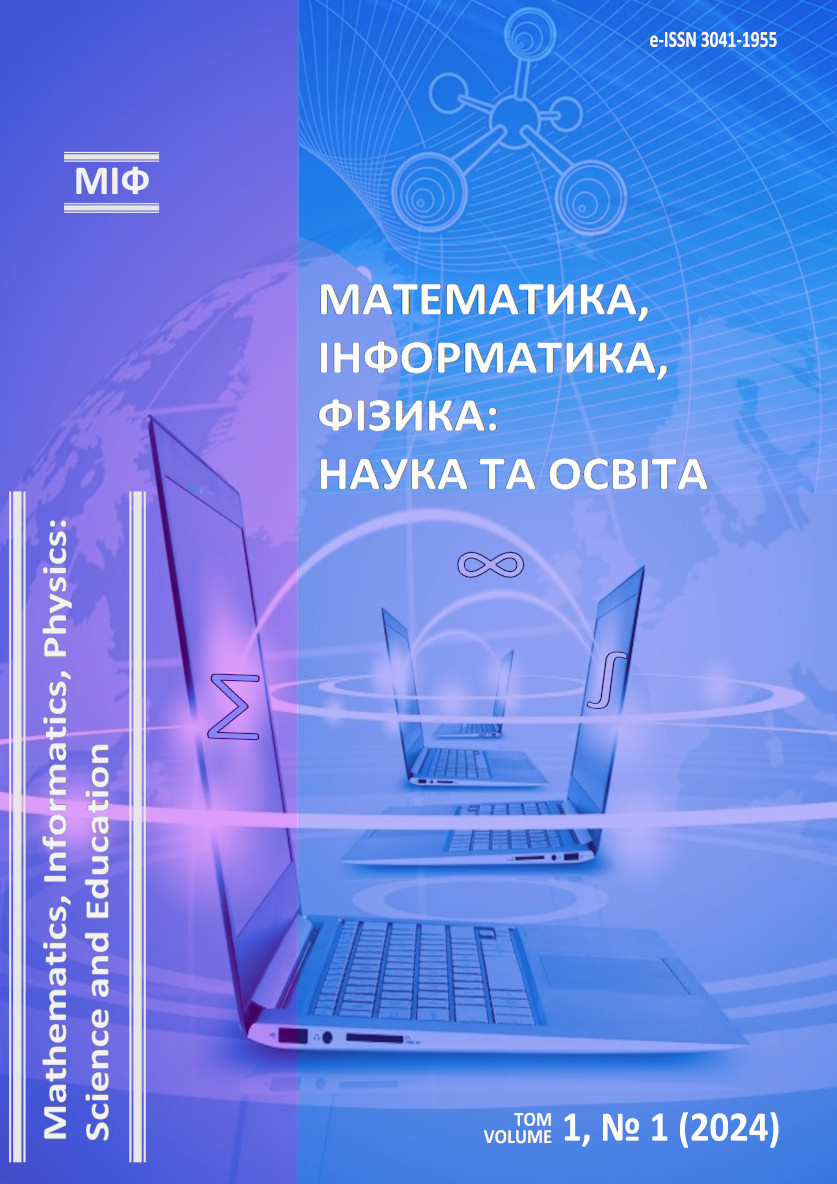Use of computer simulation tools with the purpose of increasing students' interest in the study of physics
Published 2024-06-20
Keywords
- computer simulation, computer model, study of physics, cognitive interest, increase of interes
Copyright (c) 2024 Анатолій Сільвейстр, Микола Моклюк, Марія Копитко (Автор)

This work is licensed under a Creative Commons Attribution 4.0 International License.
How to Cite
Abstract
The article analyzes scientific research on the problem of the development of cognitive interest: the essence of the concept of "cognitive interest" is considered, the features of the formation of students' cognitive interest in physics classes are described.
The directions of the introduction of information technologies into the educational process are characterized, which include the development and practical use of scientific and practical support, the high-quality and effective use of software, computer training and knowledge control systems, the systematic integration of these technologies into existing educational processes and organizational structures.
It has been found that conducting experiments that are difficult or impossible to reproduce in a real experiment can be effectively implemented based on the use of multimedia models.
Possibilities of using computer modeling during the study of physics are offered.
It has been confirmed that the use of computer simulation elements is appropriate and justified during the study of educational material, for which conducting various kinds of educational physical experiments is limited. This is the study of the basic concepts of quantum physics.
The peculiarities of the study of the "Quantum optics" section are described, in which special attention is paid to the study of the phenomenon of the photoeffect. Examples of interactive computer models are given, the use of which makes it possible to increase the interest of students in studying this material in physics, to stimulate the formation and development of cognitive activity and creative thinking, to form in students an idea of the phenomena of the microcosm, their regularities, and the modern physical picture of the world.
Downloads
References
- Богданов І. Т. Предмет, цілі і завдання вивчення загальної фізики на нефізичних спеціальностях. Зб. наук. праць Кам’янець-Подільського державного педагогічного університету. Серія педагогічна : Дидактики дисциплін фізико-математичної та технологічної освітніх галузей. Кам’янець-Подільський: К-ПДПУ, 2002. Вип. 8. С. 129–136.
- Бугайов О. І., Горбунцова Л. Г., Савченко В. І. Квантова фізика: Дидактичний матеріал.К.: Рад. школа, 1988. 88 с.
- Гончаренко С. У. Український педагогічний словник. НАПН України, Ін-т пед. освіти і освіти дорослих. Київ : Либідь, 1997. 376 с.
- Заболотний В. Ф., Мисліцька Н. А., Моклюк М. О. Використання демонстраційних комп’ютерних моделей при вивченні фізики. Сучасні інформаційні технології та інноваційні методики навчання у підготовці фахівців: методологія, теорія, досвід, проблеми: зб. наук. пр. Випуск 11 / Редкол. : І. А. Зязюн (голова) та ін. Київ-Вінниця: ТОВ фірма «Планер», 2006. С. 208–212.
- Лисий М. В., Сільвейстр А. М., Тичук Р. Б. Використання інформаційних технологій навчання в освіті. Сучасні інноваційні технології та інноваційні методики навчання у підготовці фахівців : методологія, теорія, досвід, проблеми : зб. наук. пр. / Ін-т пед. освіти і освіти дорослих АПН України, Вінницький держ. пед. ун-т ім. М. Коцюбинського. Київ-Вінниця : ДОВ «Вінниця», 2008. Вип. 19. С. 388–395.
- Моклюк М. О. Моделювання явища радіоактивності та особливості його використання учителем на уроках фізики. Збірник наукових праць Кам’янець-Подільського національного університету імені Івана Огієнка: Серія педагогічна / [редкол.: П. С. Атаманчук (голова, наук. ред.) та ін..]. Кам’янець-Подільський: Кам’янець-Подільський національний університет імені Івана Огієнка, 2011. Вип. 17: Інноваційні технології управління компетентнісно-світоглядним становленням учителя: фізика, технології, астрономія. С. 23–26.
- Моклюк М. О., Моклюк О. О., Лисий М. В. Вивчення явища радіоактивності за допомогою засобів комп’ютерного моделювання. Наукові записки. Серія: Проблеми методики фізико-математичної і технологічної освіти. Випуск 8 Частина 2. Кіровоград: РВВ КДПУ ім. В. Винниченка, 2015. С. 115–119.
- Моклюк М. О., Сільвейстр А. М. Використання комп’ютерного моделювання у вивченні фізики. Тези доповідей міжнародної науково-практичної конференції «Сучасні проблеми фізико-математичної освіти і науки», присвяченої 95-річчю від дня народження доктора технічних наук, професора Дущенка В.П. 25-26 травня 2017 року, Київ, Україна. К.: НПУ імені М. П. Драгоманова, 2017. С. 224–227.
- Муляр В. П. Комп’ютерне моделювання як засіб активізації пізнавальної діяльності учнів при вивченні розділу «Квантова фізика». Матеріали науково-практичної конференції «Пізнавальний інтерес і його вплив на процес навчання і самовиховання школярів», Луцьк, 1995. С. 12–13.
- Сільвейстр А. М. Теоретико-методичні засади навчання фізики майбутніх учителів хімії і біології : дис. … доктора пед. наук : 13.00.02. Кропивницький, 2017. 633 с.
- Сільвейстр А. М. Формування пізнавальних інтересів студентів нефізичних спеціальностей на заняттях з фізики засобами інформаційних технологій навчання. Науковий часопис Національного педагогічного університету імені М.П. Драгоманова. Серія 5. Педагогічні науки : реалії та перспективи : зб. наук. пр. К. : Вид-во НПУ імені М. П. Драгоманова, 2012. Вип. 34. С. 168–174.





